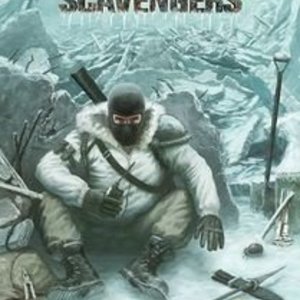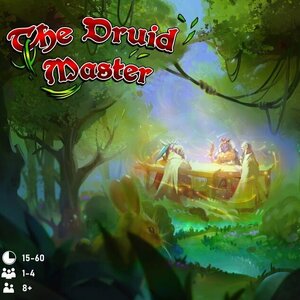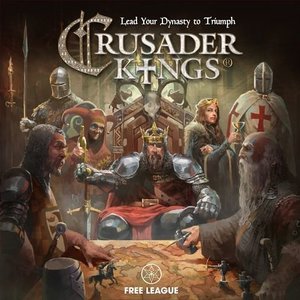
Crusader Kings
Tabletop Game
You are a Crusader King, striving for wealth, political power, religious influence, and military...
BoardGames 2018Games
Purple Phoenix Games (2266 KP) rated Arctic Scavengers in Tabletop Games
Jun 12, 2019
Welcome to the Ice Age. No, not the animated movie. I’m talking about the real deal. Arctic Scavengers is set in a post-apocalyptic ice age where the cold is deadly and the resources are scarce. Any surviving humans have banded together to form ‘tribes’ that are competing for dominance in this frigid tundra. Can you and your tribe outwit your competitors to become the most powerful group? Or will a bigger and more menacing tribe overpower you and jeopardize your survival?
Disclaimer: The solo variant is only addressed in the Recon Expansion rules. There IS another expansion – HQ – but I have not used that content in my solo plays. This review only encompasses the Base Game and Recon Expansion.
Arctic Scavengers is a deck-building game where players are recruiting mercenaries to their tribes, searching for general resources, and battling other tribes for contested resources. Each turn has two main phases – Resource Gathering and Skirmish. During Resource Gathering, you play cards from your hand to either recruit new mercenaries or search the junkyard for general resources. Any remaining cards in your hand are then used during the Skirmish phase – where the player with the highest ‘fight’ value wins the contested resource for that round. At the end of the game, the player with the biggest tribe wins!
The solo variant has some minor differences, but is played essentially the same way. In a solo game, the contested resource cards are divided into 7 skirmishes to be encountered throughout the game. You can decide when to engage in a skirmish – it is not a requirement to encounter one each turn. After each skirmish, you either win and earn a contested resource, or lose and must permanently discard a card from your losing hand. The game ends when all 7 skirmishes have been encountered. The other difference is that each time you have to re-shuffle your discard pile, you must permanently remove the top card of your new deck from the game. Beyond those changes, the game remains the same. At the end of the game, all cards in your tribe are worth certain numbers of points – the goal is to beat your own personal best score.
In theory, this game sounds super cool! But when I actually got to play it solo, I was seriously underwhelmed. The game feels stagnant in the sense that there is no tension or urgency in your strategy. Since YOU get to decide when to engage in a skirmish, it is possible to just while away the time building up your deck until you have enough cards to beat every skirmish. Yes, you permanently discard a card each time you re-shuffle your discard pile, but if you are able to recruit one or two new cards each turn, it negates the penalty of discarding a card. The ability to choose when to engage in skirmishes is seriously over-powered because there is nothing stopping you from ignoring skirmishes and amassing cards for end-game scoring.
The other grievance I have with the game is regarding the Junkyard – the deck of cards where you ‘search’ for resources. The solo rules do not explicitly address setting up the Junkyard deck at all. So do you use one or not? Not having the Junkyard deck can be a serious hinderance – certain mercenaries cannot be recruited without certain resources. If you DO play with the Junkyard, how many cards do you use? Do you use the corresponding cards from the Base game and BOTH expansions? Only Base game and one expansion? Again, not explicitly addressed. I’ve tried using all of the Junkyard cards and that is difficult – there are just too many cards in that deck. I have gone entire games without coming across a necessary resource just because the size of the deck is too large (and I’m apparently a poor card-shuffler). The simple solution to this ambiguity would have been to just address it in the rulebook. But it’s not there, so I’m left guessing as to how I should set it up every time.
I really like the idea of this game. I really don’t like the solo variant though. Not having forced skirmishes makes the game extremely boring for me – I don’t really need a strategy since I can just recruit cards until I can draw a powerful hand. If there was a timeline for skirmishes – maybe something like “You must encounter one skirmish every other turn” – the game would be vastly different. I would actually need to strategize what cards to recruit and how I should delegate my cards on turns with a skirmish. In most games, I will reach a certain point where I choose to encounter a skirmish (that I know I will lose) just because I am starting to get bored. I appreciate the sentiment of including a solo variant, but this one just does not work.
Arctic Scavengers requires decent strategy and it offers good player interaction in group games. In a solo game, however, it is just imbalanced and boring. This is one solo variant that I would not recommend that you try, unless you are including drastic house rules.
https://purplephoenixgames.wordpress.com/2019/03/06/solo-chronicles-arctic-scavengers/

My NBA 2K18
Games and Sports
App
The companion app for the award-winning NBA 2K franchise is back, with MyNBA2K18. Packed with...
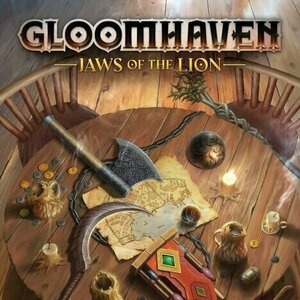
Gloomhaven: Jaws of the Lion
Tabletop Game
Gloomhaven: Jaws of the Lion is a standalone game that takes place before the events of Gloomhaven....
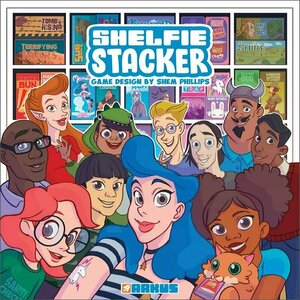
Shelfie Stacker
Tabletop Game
So you’ve picked up a new game, eh? Or did you finally get your eager hands on that expansion...
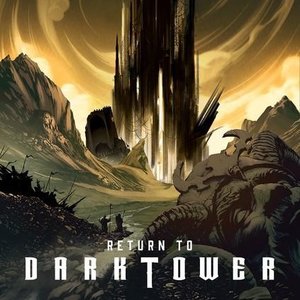
Return to Dark Tower
Tabletop Game
For an age, the tower lay in ruins. Unbeknownst to the people of the realm, a great evil stirred in...
Boardgames OldGamesMadeNew RestorationGames 2020Games
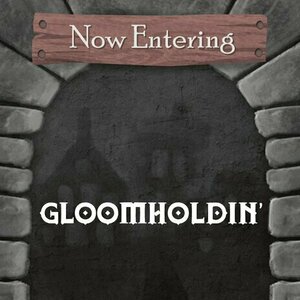
Gloomholdin'
Tabletop Game
Gloomholdin' is an 18-card, no-table-needed version of Gloomhaven. It can be played completely in...
Purple Phoenix Games (2266 KP) rated The Druid Master in Tabletop Games
Jun 2, 2021
Disclaimer: We were provided a PnP of The Druid Master for the purposes of this preview. The artwork and design of the cards is not yet finalized, so what you see pictured below is not necessarily what the production copies will look like. It is also important to note that although the game is about natural medicines/remedies, it does not replace professional medical advice and treatments. -L
In The Druid Master, players will take on the roles of (you guessed it) Druids who have mastered the ancient arts of healing, through use of plants, herbs, and other natural elements. Ailing patients will come to you (and your rivals) for help, so you must work quickly to concoct the most effective remedy to heal them back to normal! To setup for a game, each player receives a Player Screen, 1 Effect card, and 7 Plant cards. The remaining Effect and Plant cards are shuffled to form draw decks, and the Event deck is placed nearby as well. Place the deck of Patient cards facedown within reach of all players, and set the Cure tokens to the side. The game is now ready to begin!
Over the course of 8 rounds, players will be using Plant and Effect cards to best help the ailing Patient for each given round. Once the 8th and final Patient card has been resolved, points will be counted to determine the ultimate Druid Master! To start a round, an Event card will be revealed. These Events will alter the round in some way, putting your strategic thinking to the test. For example, an Event card might limit the number of cards you can play this round. After the Event is resolved, the Patient card will be revealed for all players to see. The Patient will have a list of symptoms/ailments, with a percentage corresponding to the severity of the issue. Each player will then secretly select 1-3 Plant cards from their hand to be used to heal the Patient. The different Plant cards offer remedies for the various symptoms/ailments, and also list a corresponding percentage as to how much it will help. Effect cards can also be used during this phase of the game to obtain bonuses/negatively affect opponents. Use them wisely!
Once everyone is ready, all Plant cards will be revealed, and players will determine who has best cured the Patient. Compare the percentages on your Plant cards against those of the Patient – if you have failed to completely cure a symptom, take a Cure token that represents the missing percentages from your played cure. When all Plant cards have been checked, the player that was able to Cure the Patient completely (was able to match all Patient percentages with their played Plant cards) is the winner of the round. They will take the Patient card for end-game scoring. If nobody completely Cured the Patient, the player who accumulated the least number of Cure tokens (thus curing the most Patient percentages of the group) wins the round and collects the Patient card. All Plant and Effect cards used this round are discarded, and each player will draw 2 new Plant cards for the next round. Play continues in this fashion until the 8th Patient has been Cured. Players will count up their points earned from Cured Patients, and the player with the highest score is named the winning Druid Master!
I should say right off the bat that I’m not really a person who is into natural medicine. But my personal preferences do not stop me from playing and enjoying The Druid Master. If you think about it, natural medicine is very thematically appropriate for fantasy worlds, so it makes sense in this setting. Ok, so what about the gameplay? It is very straight-forward, which lends itself to fast teaching, learning, and playing. Ultimately, you are trying to match your Plant cards as best you can to the Patient card in play. And since you can only play a maximum of 3 cards each round, you really have to consider your options. If you aren’t able to completely Cure the Patient, can you play your Plant cards in such a way that you will collect the fewest Cure tokens? It’s all about how you strategize. Another thing that I really like about the gameplay is that all Plant cards are selected secretly and revealed simultaneously. So nobody is at an advantage by being able to see that an opponent was not 100% successful. It adds a little element of risk and hidden information to the game that makes it more engaging.
As I mentioned earlier, this is a PnP version of the game, so these components are not what will be received in a production copy. Also, the card layouts and artwork are not completely finalized either. But going on what I have, I do like the simplicity of the components. The symbolism is clear, the percentages are easy to read, and the text/pictures are informational as well. Once this game is printed on real cards and with cardboard tokens, I know it will be a decent quality production.
So overall, how does The Druid Master fare? I’d say fairly well. The rules and gameplay are straight-forward, it is fast and easy to teach and play, and it keeps all players engaged throughout the entire game. This is certainly not the most complicated or heavy game in existence, but it does offer hints of strategy that will keep the gameplay fresh and players invested. If you are looking for a nice little filler-type game set in a fantasy realm, I would recommend checking out The Druid Master. It is coming to Kickstarter soon, so be on the lookout!

Werewolf "Nightmare in Prison"
Games and Education
App
◆◇◆◇◆ Thank you for 6,000,000 DL! ◆◇◆◇◆ The werewolf game that is poplar in...

Werewolf Special Package
Games and Entertainment
App
◆◆ Werewolf Special Package Version!! ◆◆ You can use the all pay cards! ◆◇◆◇◆...
